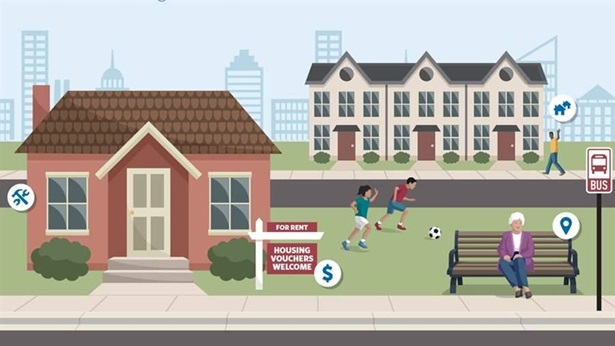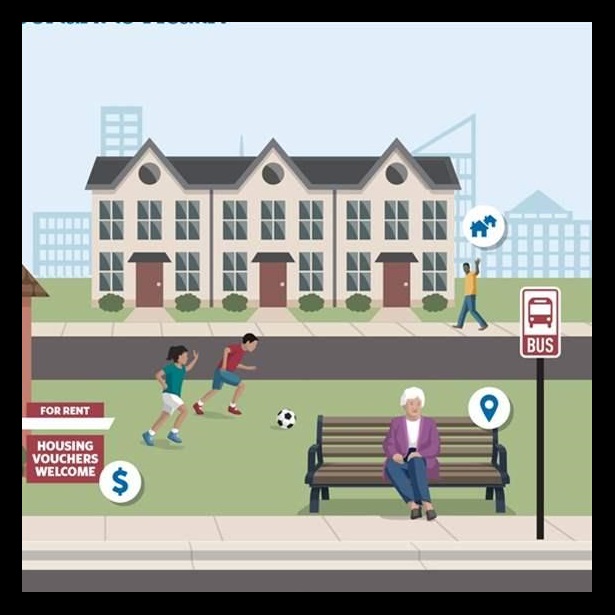Guidance for Housing Professionals
Health impact assessment and housing
 © Hero Images
© Hero ImagesThe housing sector can play a substantial role in controlling health care costs.
About this brief
This brief draws from a report developed by the National Center for Healthy Housing, the Health Impact Project, and the Center for Housing Policy that summarizes a review of 40 housing HIAs conducted in the U.S. between 2002 and 2013, provides guidance for future housing assessments, and offers a helpful tutorial on housing programs.
Overview
The housing and public health sectors have a long history of working together to protect and promote health. Beginning in the late 19th century, efforts to eradicate infectious diseases, including typhoid, cholera, and tuberculosis, resulted in policies and programs, such as building codes and housing inspection systems, that have been critical in improving housing quality and preventing disease for more than 100 years.1 Today, as scientific understanding of and policymaker attention to the impacts of physical environments on health have evolved, professionals engaged in housing, community development, and planning once again have a critical role in curbing negative health outcomes and their associated costs.
Over the past 15 years, research has consistently demonstrated the link between housing and health.2 For example, a lack of affordable housing not only affects people’s ability to acquire and maintain adequate shelter but also limits their capacity to meet other basic needs.3 Financial constraints can force families to make tough choices between paying for rent, utilities, food, or medical care.4 The design and quality of housing can also affect health outcomes such as asthma, cardiovascular disease, cancer, and injury, while location and social, economic, and built environments in surrounding neighborhoods can improve or constrain access to health-supportive resources, opportunities, and social networks and relationships among neighborhood residents.
Nationwide, housing officials are at the forefront of efforts to address many of these challenges by building affordable housing, supporting improvements in neighborhood infrastructure, and advancing social and economic opportunities. Every day, decision-makers in the housing sector have chances to consider health in their policies, programs, and projects in order to help mitigate pressing public health problems such as cancer, depression, obesity, injury, asthma, and diabetes that take a toll on Americans’ quality of life and substantially increase health care costs for taxpayers. Understanding how to integrate public health considerations into housing decisions can improve the health of residents and the quality of the environment and ensure strong financial stewardship of public funds.
This brief introduces housing professionals and policymakers to the concept of health impact assessments (HIAs) and explains how these studies can improve decisions about projects, policies, and programs in the areas of housing and community development. It draws upon findings from a review, conducted by the National Center for Healthy Housing (NCHH) in consultation with the Health Impact Project and the National Housing Conference, of 40 HIA reports on housing-related programs, projects, and policy decisions conducted in the U.S. between 2002 and 2013.5 For each HIA reviewed, NCHH identified information such as the lead organization, the health determinants and outcomes assessed, data sources and analytic methods used, methods of stakeholder engagement, and priority recommendations.
Housing matters to health
Many of the nation’s most pressing public health problems, such as asthma, depression, diabetes, and obesity, are influenced by the places where people live, work, and play. For example, an estimated 21 percent of asthma cases in the U.S. are attributable to dampness and mold exposure in housing.6 Similarly, the difficult trade-offs that many families must make among paying for essential items such as rent and food, commonly referred to as material hardship, have implications for health through food insecurity, exposure to extreme temperatures, housing instability, or forgone medical care and medications. Many families also make tough choices between affordability and quality in their housing, often sacrificing one for the other.
Further, neighborhood characteristics, such as availability of public transportation and grocery stores, levels of racial and economic segregation, crime rates, and perceived safety are also important factors for health. For example, racial and economic segregation is a well-documented predictor of health disparities for racial and ethnic minority populations and can restrict access to educational and employment opportunities, healthy foods, medical care, and other health-promoting resources.7 Additionally, studies have shown that living in close proximity to high-volume roads and the resulting exposure to air pollution can lead to increased rates of respiratory disease, such as asthma and bronchitis, as well as increased hospital visits.8
What is a health impact assessment?
HIA is a rapidly growing field that can help decision-makers make better choices by bringing together scientific data, health expertise, and public input to identify the potential and often overlooked effects, both positive and negative, of proposed laws, regulations, projects, policies, and programs on public health.9 Federal, state, and local organizations are increasingly using HIAs to help housing and community development professionals consider health implications when making decisions.10
HIAs broadly take into account environmental, social, and economic factors related to health and evaluate the potential impacts of a proposed project, plan, program, or policy on the health and well-being of the community, including the full range of potential positive and negative effects. HIAs employ a variety of data sources, including qualitative and quantitative analysis and input from stakeholders, to identify health concerns related to the proposal and to determine how these impacts may be distributed among the population, especially vulnerable groups such as seniors, children, and low-income families. Finally, HIAs provide pragmatic, evidence-based recommendations about how to reduce risks, promote benefits, and monitor the health effects of the implemented decision.11
The value of HIAs
HIAs offer housing decision-makers and those affected by proposed projects, plans, programs, or policies numerous benefits. They can provide evidence to inform the decision-making process, giving stakeholders an opportunity to consider potential impacts and weigh options. They also are flexible tools, readily adaptable to fit the scope, resources, and timeline of any given housing decision.12 By explicitly considering health in housing and community development initiatives, housing professionals and policymakers can:13
- Reduce unit turnover and the substantial associated costs. Two recent studies found that residents, particularly the elderly, had health improvements, including fewer falls and better mental health, after their homes were renovated using green building practices, which focus on conserving resources and supporting health through design, construction, and operations. Such efforts have the potential to enable residents to stay healthier and remain in their homes longer, which may decrease the costs of administration, advertising, repair, and lost income associated with tenant turnover.14 Additionally, by incorporating a health focus into the construction, rehabilitation, and maintenance of properties, housing professionals may also enhance the overall marketability and economic value of their developments.
- Leverage partnership opportunities available through the Affordable Care Act (ACA). With its emphasis on improving health through changes outside the health care system, the ACA paves the way for housing officials and community developers to partner with public health and health care practitioners in new, strategic ways.15 For example, nonprofit hospitals are required to undertake initiatives and activities to improve local health, commonly known as community benefits, in order to maintain their nonprofit status. The ACA strengthened these community benefit requirements and required hospitals to report on their efforts in a standardized way.16 In 2011, the federal government further clarified that some community-building activities—which may include housing and physical improvement—may qualify as community benefits.17 HIAs can bring housing organizations, hospitals, public health practitioners, and Accountable Care Organizations (ACOs)—networks of doctors, hospitals, and other health care providers who provide coordinated care to their Medicare and Medicaid patients—together to have a collective impact. These collaborations can yield new funding streams or business ventures, as well as opportunities to blend resources across the housing and health sectors to provide more efficient and effective service delivery, such as shelter for an ACO’s high-cost patients. For example, a nonprofit hospital in Columbus, Ohio, has partnered with a faith-based community development corporation, the local government, and other organizations to build and rehabilitate affordable housing in its immediate neighborhood.18
- Build community and decision-maker buy-in and support for proposed actions. A study of professionals in the diverse fields of health care, public health, housing, transportation, education, human services, early childhood education, and community development finance found that community engagement can influence the success of projects and collaboration can create new opportunities to leverage and pool funding sources and spread financial risk.19 Having a range of stakeholders and decision-makers at the table early in the process improves buy-in for a project because all the affected parties have been involved and are invested in the process.20
Previous evaluations of the impact of HIAs suggest that, in addition to directly influencing some decisions, they can improve collaboration among stakeholder groups and give community members a stronger voice in decisions that affect them.21 The inclusiveness of the HIA process and the level of stakeholder engagement can help ensure the integrity and transparency of the development process. All stakeholder groups review the HIA findings to help inform recommendations. One of the critical lessons learned from the first HIAs conducted in the U.S., which were undertaken by the San Francisco Department of Public Health (SFDPH), was 10 how to engage with and inform stakeholders from sectors outside public health.22 An evaluation of one SFDPH assessment found that “72 percent of the participants from community-based organizations, the private sector, and government agencies reported an improved relationship—including more-open communication, increased trust, and greater sharing of information—with the Department of Public Health.”23
Housing and community development professionals often have experience in community building and stakeholder engagement in the neighborhoods they serve and often undertake these efforts as part of their initiatives. Therefore, the stakeholder engagement process for HIAs focused on housing decisions should seek to complement and strengthen, rather than duplicate, existing engagement efforts for a given project or decision. - Strengthen and complement analyses required by law. In considering not only the probable effects of proposed projects, plans, programs, and policies but also the likely health outcomes of those effects, HIAs go beyond the analyses of potential building and development impacts that are traditionally required by law. For example, although Environmental Impact Assessments (EIAs) may be required for some federally funded housing projects, their analyses are often limited to explaining the proposed project’s impact on the environment (e.g., water, soil, and particulate matter). An EIA might examine the effect of new development on traffic counts, but it would not typically extend the analysis to evaluate the impact of changes in traffic volume on issues such as pedestrian injuries or asthma.
Getting started
Here are some simple first steps that housing officials can take:
- Determine whether HIA is the most appropriate tool for ensuring that health is considered in a given housing decision. Proposed projects, programs, plans, and policies pertaining to public housing programs, housing choice voucher programs, project-based rental assistance, low-income housing tax credits, code enforcement and inspection policies, and zoning decisions may all be suitable for HIA.
- Attend a training session on how to conduct an HIA. See the selected resources listed above to find an organization offering HIA information and training. Local colleges and universities may also offer courses on HIA.
- Reach out to national HIA experts and organizations that support HIA practitioners. Many organizations are working around the country to advance the use of HIA in decision-making. These experts can offer advice about how to get started. (See “Selected Resources.”)
- Use existing data sources to examine the project’s potential connections to health. Readily available data sets can help officials and developers identify prevalent public health issues among the communities most likely to be affected by the proposed project, program, or policy.
- Review available online tools. Explore SOPHIA’s minimum elements and practice standards (http://hiasociety.org/wp-content/uploads/2013/11/HIA-Practice-Standards-September-2014.pdf), the Healthy Community Design Checklist Toolkit available on the Centers for Disease Control and Prevention’s website (http://www.cdc.gov/healthyplaces/toolkit), or the San Francisco Indicator Project’s website (http://www.sfindicatorproject.org) to find ways to start incorporating health issues into proposed actions.
- Identify a local health practitioner. Staff members from local health departments, public health institutes, public health nonprofits, and public health departments at local colleges and universities may have experience and an interest in partnering on an HIA.
- Determine what organizational resources (staff and funding) are available to conduct an HIA and the timeline for the decision. Early screening and scoping can determine whether a full HIA, rapid HIA, or other tool is the best approach to understand the health effects of the proposed housing project, plan, or policy.
An HIA will not be the most appropriate tool for all housing decisions and should be conducted only when the program, policy, or project is likely to have important health implications and when the assessment can yield important, new, and actionable recommendations. HIAs should also focus on a priority set of issues that are feasible to assess within resource, timeline, and other constraints. When used appropriately, HIAs can help housing officials and public health professionals improve public health outcomes, lower health care costs for families and local governments, create healthier housing and communities, and better our built environment, while maintaining strong financial stewardship of local funds.
Endnotes
- U.S. Department of Health and Human Services, Office of the Surgeon General, “The Need for Healthy Homes,” in The Surgeon General’s Call to Action to Promote Healthy Homes (2009), accessed Dec. 9, 2015, http://www.ncbi.nlm.nih.gov/books/NBK44192/; and Margaret Garb, “Health, Morality, and Housing: The ‘Tenement Problem’ in Chicago,” American Journal of Public Health 93, no. 9 (2003): 1420–1430, doi:10.2105/AJPH.93.9.1420.
- David E. Jacobs and Andrea Baeder, Housing Interventions and Health: A Review of the Evidence, National Center for Healthy Housing (2009), accessed Oct. 10, 2014, http://www.nchh.org/Portals/0/Contents/Housing%20Interventions%20and Health.pdf.
- Mark Nord and Linda S. Kantor, “Seasonal Variation in Food Insecurity Is Associated With Heating and Cooling Costs Among Low-Income Elderly Americans,” Journal of Nutrition 136, no. 11 (2006): 2939–2944, http://jn.nutrition.org/content/136/11/2939.full.pdf+html; National Energy Assistance Directors’ Association, “National Energy Assistance Survey” (November 2011), accessed Jan. 24, 2014, http://neada.org/wp-content/uploads/2013/05/NEA_Survey_Nov11.pdf; Tina L. Palmieri and David G. Greenhalgh, “Increased Incidence of Heater-Related Burn Injury During a Power Crisis,” Archives of Surgery 137, no. 10 (2002): 1106–1108, doi:10.1001/archsurg.137.10.1106; Lynn Page Snyder and Christopher A. Baker, Affordable Home Energy and Health: Making the Connections, AARP Public Policy Institute (2010), http://assets.aarp.org/rgcenter/ppi/cons-prot/2010-05-energy.pdf; P. She and G.A. Livermore, “Material Hardship, Poverty, and Disability Among Working-Age Adults,” Social Science Quarterly 88 (2007): 970–989, doi:10.1111/j.1540-6237.2007.00513.x; and Sarah A. Burgard, Kristin S. Seefeldt, and Sarah Zelner, “Housing Instability and Health: Findings From the Michigan Recession and Recovery Study,” Social Science & Medicine 75, no. 12 (2012): 2215–2224, doi:10.1016/j.socscimed.2012.08.020.
- Ibid.
- For more detail on these 40 HIAs and review methods, see National Center for Healthy Housing and National Housing Conference, A Systematic Review of Health Impact Assessments on Housing Decisions and Guidance for Future Practice (2016), http://www.nchh.org/Portals/0/Contents/Guidance-for-Conducting-HIAs-on-Housing-Decisions.pdf.
- D. Mudarri and W.J. Fisk, “Public Health and Economic Impact of Dampness and Mold,” Indoor Air 17, no. 3 (2007): 226–235, http://www.ncbi.nlm.nih.gov/pubmed/17542835; and Jacobs and Baeder, Housing Interventions and Health.
- D.R. Williams and Pamela Braboy Jackson, “Social Sources of Racial Disparities in Health,” Health Affairs 24, no. 2 (2005): 325–334, doi: 10.1377/hlthaff.24.2.325; and James S. House and David R. Williams, “Understanding and Reducing Socioeconomic and Racial/Ethnic Disparities in Health,” in Promoting Health: Intervention Strategies From Social and Behavioral Research, eds. Brian D. Smedley and S. Leonard Syme (Washington: National Academies Press, 2000), 81–124, http://www.nap.edu/read/9939/chapter/7.
- California Environmental Protection Agency, California Air Resources Board, Air Quality and Land Use Handbook: A Community Health Perspective (2005), 8–11, accessed May 21, 2015, http://www.arb.ca.gov/ch/handbook.pdf; W. James Gauderman et al., “Effect of Exposure to Traffic on Lung Development From 10 to 18 Years of Age: A Cohort Study,” Lancet 369, no. 9561 (2007): 571–577, doi:10.1016/ S0140-6736(07)60037-3; and Ying-Ying Meng et al., Living Near Heavy Traffic Increases Asthma Severity, UCLA Health Policy Research Brief (2006), accessed May 21, 2015, http://healthpolicy.ucla.edu/publications/Documents/PDF/Living%20Near Heavy%20Traffic%20Increases%20Asthma%20Severity.pdf.
- Health Impact Project, “About Health Impact Assessment,” accessed Oct. 6, 2014, http://www.pewtrusts.org/en/projects/healthimpact-project/health-impact-assessment.
- Health Impact Project, “Health Impact Assessments in the United States,” accessed Nov. 20, 2015, http://www.pewtrusts.org/en/multimedia/data-visualizations/2015/ hia-map.
- Ibid; and National Research Council, Improving Health in the United States: The Role of Health Impact Assessment (Washington: National Academies Press, 2011), 5, accessed July 8, 2014, http://www.nap.edu/catalog.php?record_id=13229.
- Health Impact Project, Health Impact Assessment: Bringing Public Health Data to Decision Making, accessed May 28, 2015, http://www.pewtrusts.org/en/~/media/Assets /External-Sites/Health-Impact-Project/healthimpactassessmentbringingpublichealthdatatodecisionmaking.pdf.
- Brittany Chen et al., The Business Case for Healthy Development and Health Impact Assessments, Health Resources in Action and Metropolitan Area Planning Council (2014), accessed Jan. 15, 2015, http://www.hria.org/uploads/pdf/CITCBusinessCase.pdf.
- Jill Breysse et al., “Self-Reported Health Outcomes Associated With Green-Renovated Public Housing Among Primarily Elderly Residents,” Journal of Public Health Management and Practice 21, no. 4 (2015): 355–367, doi:10.1097/PHH.0000000000000199; Sherry Ahrentzen et al., The Green Apple Research Project: Health Outcomes of a Green Housing Retrofit for Older Adults in Phoenix, Arizona, Arizona State University with University of Florida and Lawrence Berkeley National Laboratories (2013), accessed Jan. 30, 2015, https://stardust.asu.edu/docs/stardust/green-apple-project/final-report-2013.pdf; and Thomas J. Miceli and C.F. Sirmans, “Tenant Turnover, Rental Contracts, and Self-Selection,” Journal of Housing Economics 8, no. 4 (1999): 301–311, doi:10.1006/jhec.1999.0253.
- Chen et al., The Business Case; Donald M. Berwick, Thomas W. Nolan, and John Whittington, “The Triple Aim: Care, Health, and Cost,” Health Affairs 27, no. 3 (2008): 759–769, doi:10.1377/hlthaff.27.3.759.
- Martha H. Somerville et al., Hospital Community Benefits After the ACA: Community Building and the Root Causes of Poor Health, The Hilltop Institute (October 2012), accessed Dec. 30, 2015, http://www.hilltopinstitute.org/publications/ hospitalcommunitybenefitsaftertheaca-schedulehissuebrief5-october2012.pdf.
- Sara Rosenbaum, Amber Rieke, and Maureen Byrnes, Encouraging Nonprofit Hospitals to Invest in Community Building: The Role of IRS ‘Safe Harbors,’ Health Affairs Blog (Feb. 11, 2014), accessed Dec. 30, 2015, http://healthaffairs.org/blog/2014/02/11/encouraging-nonprofit-hospitals-to-invest-in-community-building-the-role-of-irs-safe-harbors/. 18
- Nationwide Children’s Hospital, “Affordable Housing,” accessed Dec. 31, 2015, http://www.nationwidechildrens.org/healthy-neighborhoods-healthy-families-affordable-housing.
- Paul W. Mattessich and Ela J. Rausch, Collaboration to Build Healthier Communities, Robert Wood Johnson Foundation Commission to Build a Healthier America (2013), accessed Jan. 15, 2015, http://www.rwjf.org/en/research-publications/find-rwjf-research/2013/06/collaboration-to-build-healthier-communities.html.
- Design for Health, “Building Public Understanding: The Link Between Health and Planning,” University of Minnesota, accessed July 19, 2014, http://designforhealth.net/wp-content/uploads/2012/12/BCBS_PublicPart_091007.pdf.
- Emily Bourcier et al., “Do Health Impact Assessments Make a Difference? A National Evaluation of HIAs in the United States,” Center for Community Health and Evaluation (April 2014), accessed Dec. 7, 2015, http://www.rwjf.org/content/dam/farm/reports/issue_briefs/2014/rwjf409204.
- Rajiv Bhatia and Jason Corburn, “Lessons From San Francisco: Health Impact Assessments Have Advanced Political Conditions for Improving Public Health,” Health Affairs 30, no. 12 (2011): 2410–2418, doi:10.1377/hlthaff.2010.1303.
- Ibid.


Guidance for the Public Health Sector
Health impact assessment and housing


The Relationship Between Housing and Health
Learn More

America’s Overdose Crisis
Sign up for our five-email course explaining the overdose crisis in America, the state of treatment access, and ways to improve care
Sign up








